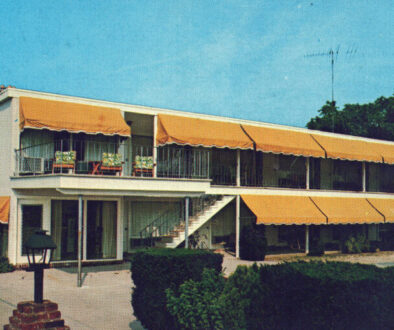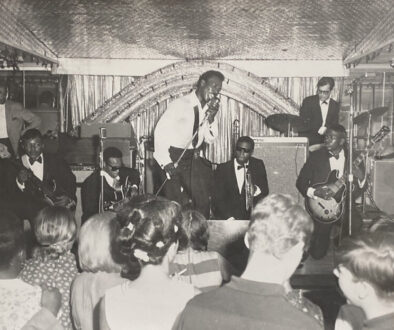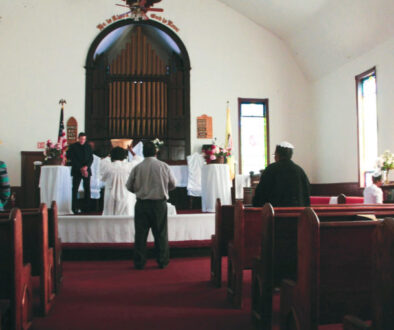Union Bethel Cemetery
Paying respects to Cape May’s African American Civil War Soldiers
Go a little too fast along Tabernacle Road, near Fishing Creek, or glance over at the wide expanse of preserved farmland across the way, and you’re likely to miss it: the sign nestled among trees marking Union Bethel Civil War Cemetery.
Pull onto the gravel drive next to the marker, adjacent to yellow clapboard houses, and there’s no sign of a cemetery. But, walk a short way down a dirt path, cross a wooden footbridge, and you leave behind the modern world.
Sunlight dapples through the very tall trees overhead, birdsong fills the air. Before you stretches a wide expanse of grass, dotted with 19th century headstones. The scene, and inscriptions on the stones, pull you back to a time that has left its mark on today, a time dominated by the great issues of slavery, racial injustice, and states’ rights.

This is Union Bethel Cemetery, the final resting place of more than a dozen African American Union Army soldiers, proud members of the United States Colored Troops. Their families are buried around them. Flags marking all the graves flutter in the breeze.
Seventy-three graves in the cemetery were recorded in a site survey 20 years ago. But with many broken headstones, unmarked indentations in the earth and lost wooden markers, many more bodies may lie at rest, both in the cemetery area and in the adjacent woods.
The cemetery harkens back to 1831 when a new and expanding community of free blacks in the area, numbering over 100 people, realized they needed space for both religious worship to bury their dead. So five trustees of the African American church in Lower Township, the First Methodist Church, bought just over two acres for 25 cents. They procured the land from Thomas Hughes, whose family had been the largest slave holders in Lower Township. The land was designated for the “sole use of erecting a meeting house and burying ground,” according to the deed on file at Cape May Courthouse. The community cleared the land, began burying their dead, and built a church which also functioned as a school. Today, only the cemetery remains. The church/school was moved nearby to Shunpike, and is used as a private residence.
The black community along Tabernacle Road was a byproduct of slavery. Some people living there had been enslaved in Cape May, freed, and stayed in the area. Others, enslaved elsewhere, escaped and decided to settle in Cape May. Community members worked on farms, in private homes, and were fishermen and mariners.
Some later recounted to family and friends their role in the Underground Railroad, helping freedom seekers find their way to safer places. Stories in the local press of the time dovetail with these statements.
New Jersey, in 1804, enacted a gradual emancipation act, the last northern state to do so. The law did not free anyone then enslaved. But their children, at least those born after the law’s passage, were declared free when they reached their twenties.
Whether for religious, economic, or other reasons, many people were freed before the law’s provisions took effect. That included two of the trustees who signed the deed for the cemetery, Derick Turner and Peter Murkin, the latter enslaved by the Hughes family. County documents list them as being freed in 1819 and 1818, respectively.
One of the oldest graves visible in the cemetery today is that of Edward Turner, who died in 1836, undoubtedly a relative of Derick Turner. Edward Turner’s son, Reverend Edward Turner, one of the church’s first preachers, was listed in church records as Superintendent of the Sunday school.
“My grandfather, Edward Turner, took care of that cemetery,” recalled the minister’s grandson, James Allison, in a recently discovered interview from 1983. “He lived right across from it, near the apple orchards. There was a church that used to sit in the cemetery. It was also where my mother went to school. Robert Cox [another of the five trustees who created the cemetery and church] was the schoolmaster. The church was called Union Bethel. By Shunpike, there was nothing but woods.”
The Turners, along with the Gibbs and Cox clans, owned extensive tracts of land nearby. “Edward Turner’s mother owned land from Fishing Creek Road to Mr. Leaming’s property. They owned far back,” noted Allison.
People fleeing slavery in Maryland and Delaware across Delaware Bay came through Cape May, as William Still, head of the Underground Railroad in the northeast, detailed in a book he wrote after the Civil War. Still interviewed everyone who came through his Philadelphia office, and wrote at least three accounts of people fleeing to Cape May. Two of his stories describe freedom seekers braving dangerous currents and stormy seas to row to New Jersey.
When they arrived at the Jersey shore, these brave people sought help to continue their journey. Some found it at the free black community along Tabernacle Road, according to William J. Moore, principal of the segregated West Cape May African American Elementary School for 50 years.
Moore became friends with some of these original settlers when he arrived in Cape May in 1895. “Edward Turner operated a station of the Underground Railroad, located back in the forest near his home, helping many fugitive slaves on their way,” Moore later wrote in an article for the Cape May County Magazine of History and Genealogy.
A group of four people from Delaware landed at Fishing Creek on June 20, 1858, near Turner’s home, according to that week’s Cape May Ocean Wave. Someone, perhaps Edward Turner or one of his relatives or friends, helped them make their way to Gloucester County. “The runaway slaves,” reported the newspaper the following week, “have not since been heard of in these parts. The owners from Delaware came over in pursuit of them, but they were among the missing. We glory in the spunk of our ebony friends…We have since heard that they had been heard from, taken care of by a Quaker in Gloucester.”


At least 17 men interred at Union Bethel Cemetery, a majority of the men buried there, enlisted in the Union Army. Free blacks throughout the north desperately wanted to join the war effort. But, when Lincoln, in July, 1861, called for volunteers, blacks were not welcomed into the army.
That didn’t deter many from trying, and some began drill practices. In New York, the black community presented the governor with three regiments of soldiers, armed, clothed and ready to fight, but he refused to accept the troops.
It was not until 1863—when Lincoln issued the Emancipation Proclamation, freeing all slaves in secessionist states—that this changed. The Proclamation shifted the Civil War from a battle over states’ rights to a war to end slavery. The new law also gave the green light to recruitment of African American troops. Ultimately more than 179,000 African Americans served as Union Army soldiers, and another 19,000 in the Navy. Nearly 40,000 died over the course of the war.
In Cape May, the community around Union Bethel Cemetery eagerly enlisted. At least a dozen Cape May men served in the 22nd United States Colored Infantry. About half of them are buried in Union Bethel Cemetery.
The 22nd was organized in Philadelphia in January, 1864, and its men quickly deployed to Virginia, constructing fortifications and protecting supply transports while skirmishing with Confederate cavalry.
The 22nd participated in the horrendous trench warfare and bloody battles around Petersburg and Richmond. This was the confrontation between Union General Ulysses Grant’s troops and those of Confederate General Robert E. Lee, a face-off that ultimately led to Lee’s surrender at Appomattox.
On June 15, 1864, the 22nd overran a Confederate trench line, and seized a well-fortified enemy fort, part of Grant’s attack on Petersburg. Grant then ordered the assault on Richmond, in which the 22nd participated.
The valor displayed by the 22nd Regiment led its Captain, Albert Janes, to write headquarters that “in all the maneuvering the most unflinching bravery was displayed by both officers and men.” When the Confederate Capitol finally fell, the 22nd regiment led the Union forces into the smoldering city, putting out fires as they went through Richmond.
Their heroism came at a stiff cost; 72 men were killed in the regiment. Another 145 soldiers died of disease, in part resulting from their months in the trenches.
Less than two weeks after the fall of the Confederate Capitol, Lincoln was assassinated. The 22nd regiment was called to Washington, D.C. to lead his funeral procession. Then they deployed to Maryland, to help hunt down his killer, John Wilkes Booth.
Even after Booth’s capture, they were not done with military service. They deployed to the border with Mexico to intimidate the French, who had installed an Emperor there. In October, 1865, their Army service finally ended.
A handful of Cape May men also deployed with the 25th Regiment, and several veterans are buried in the cemetery. The regiment was divided in two, and they sailed separately for Texas. One wing was in a boat that started sinking off North Carolina, an area where Union troops were under attack. The 25th was immediately pressed into service defending local towns.
The other wing of the regiment disembarked in New Orleans, and was soon sent to Florida. They protected Pensacola harbor and helped strengthen area forts against a possible siege. The men suffered terribly from scurvy, with more than 150 dying. Many more were seriously disabled. Even with four or five men dying each day, the regiment was eager to fight. In a letter to the African Methodist Episcopal Church’s newspaper, The Christian Recorder one regimental soldier declared that, “We came here to fight for liberty and right, and we intend to follow the old flag as long as there is a man left to hold it up to the breeze of heaven.”
In the end, the 25th did not see active combat, and its colonel wrote that his men “always felt this a grievance.” But, he added, “I never for a moment doubted what would be its conduct under fire. It would have done its full duty beyond question.”
Other Civil War veterans buried in Union Bethel Cemetery served with the 45th Regiment and on the gunboat Seneca. There are also several veterans from 20th-century military units.
Although the Army had an on-again, off-again policy of allowing people of color into its ranks, the Navy always included black sailors. So, it is not surprising that some were buried at Union Bethel Cemetery. A granite headstone erected by American Legion Post 193 in Cape May honors nine sailors who, it says, were found on Delaware Bay Beach circa 1850. Their names, their branch of service and even why they were listed as sailors, is still a mystery, something a visitor can ponder seated on one of three stone benches surrounding the gravesite.
The cemetery is also the final resting place of members of the Batteast family, including the son and other relatives of John Battiste. Cape May lore holds that Battiste was a pirate. Indeed, he was arrested and tried for such, although acquitted, and his testimony indicates he was a bystander to crew members who actually did commit piracy on the high seas.
Battiste was cook and steward on a ship sailing from Philadelphia to French West Africa, then to French Guiana. He recounted his story in sworn testimony against one of the crew members, reprinted in an 1829 edition of the Salem Massachusetts Gazette.
Saturday night, after the ship left Guiana to return to Philadelphia, Battiste was awoken by the sound of fighting on deck. He rushed up in time to see the captain, badly beaten, hurled overboard by five mutineers. They then took on the first mate and heaved him overboard. A French passenger was
murdered below.
These crew members then drank the captain’s liquors, ate his cheeses and stole his money. Thirty days later, they ran the ship aground near New York. Battiste, clearly not hiding, returned home to Cape May, and was soon arrested, as was one other crew member, the only one they could find. After testifying, Battiste was freed and returned to Cape May. The court dismissed the charges against the other crew member, saying it did not have jurisdiction.
Union Bethel Cemetery was cared for in its early days by Edward Turner, as his grandson James Allison noted. Over time, other family and friends took on the task. In the 1920s, Allison formed an association of young men that went every spring to tidy it up, along with members of the Benevolent Club. During the 1930s, the federal government’s CCC (Civilian Conservation Corps), helped as well. Allison and a cemetery board met with county officials to have the road into the cemetery widened for wagons and cars.
But, over time, many of the African American families connected with the cemetery moved out of the area. The cemetery fell into disrepair. From time to time, the County sent someone to clear the grounds, as did veterans groups, and local school clubs. Several years ago, an Eagle Scout built a wooden walkway and put in a flagpole and pavers. A Boy Scout troop and the Coast Guard all contributed time over the years.
Over the past few years, heavy storms took their toll. Many large trees and limbs fell on the grounds and headstones dislodged and cracked apart.
In 2017, an article in the Press of Atlantic City about the cemetery’s disrepair caught the attention of local middle school teacher, Paul Schulte, as well as Lower Township’s Historic Preservation Commission. Both groups joined forces to renew the cemetery.
Schulte teaches at Richard M. Teitelman Middle School, and oversees its Builder’s Club. The group’s two dozen plus members agreed with Schulte that helping to clean up the cemetery would be a great way to give back to the community. And that’s in fact the goal of the group, an arm of the Kiwanis Club of Cape May.

Partnering with the students, members of the Historic Preservation Commission took action. A member, Judy Gillis, who also works for Lower Township, arranged to have the Public Works department take out some large trees threatening to fall, and arranged for a dumpster on-site.
Four cleanup days were organized in the first half of 2017. Students and their parents, along with a dozen or so Historic Preservation Commission members and families, especially Kim Ford and Jacqueline Moon, as well as volunteers from the Fire Department and Cape May’s Chalfonte Hotel, and members of the general public joined in. Some days as many as 50 people worked the site. Some adults brought chain saws and cut the fallen trees into pieces. Students hauled them to the dumpster. The Erma Fire Department removed stumps. Another half dozen stones were discovered under the debris.
In May 2017 the Cemetery was re-dedicated, with State Senator Jeff Van Drew and Assemblymen Bob Andrzejcazck and Bruce Land attending. The Cape May County Veterans Service Office donated a new flag for the pole at the entrance.
The following fall the team came back twice to rake leaves and spruce the site up. And they did so again this past spring. The Kiwanis Club provided flags for each grave. Historic Preservation Commission member Rudy VonColln has been cutting the grass regularly and has begun to clean some of the more compromised stones with a special agent. Mike Conlin, of Conlin Fuel, is helping to lift and stabilize some of the stones.
Schulte and his students have been awarded commendations from Lower Township, from the Cape May County Freeholders and from the New Jersey Legislature. Schulte has also been recognized as Teacher of the Year by the VFW District 17 and by the Cape May Veterans for Foreign Wars Post 386.
This fall, the Historic Preservation Commission and Builder’s Club plan additional cleanup days. Longer term, they hope to pinpoint the site of the original church and possibly build a replacement.
“No veteran should ever be forgotten,” Schulte says fervently. “They were fighting for their brothers’ and sisters’ freedom. Cape May has a history of slavery and they were descendants of freed slaves fighting for freedom for everyone. They should rest in the peace and honor that they so rightly deserve.”



